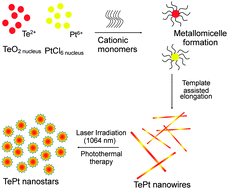Tellurium platinate nanowires for photothermal therapy of cancer cells
Abstract
Among the most celebrated modes of cancer treatment, photothermal therapy has been the most promising tool over the past few years. In spite of the introduction of many novel nanomaterials for photothermal therapy, there is still plenty of room for exploration of naïve materials. We have explored the photothermal properties of metal chalcogenides, namely tellurium platinate nanowires (TePt NWrs), in this work. Upon irradiation with a laser (Ti:sapphire laser, 808 nm) the temperature of the aqueous suspension of TePt NWrs was found to increase to ∼62 °C from room temperature at optimum concentrations. This was due to the stability and high photothermal transduction efficiency of nanorods (NRs) i.e. ∼47%. The power to ablate tumor cells was studied using A549 cells and tumor grafted experimental mice models. After an initial exposure for 10 min (808 nm laser at 1 W cm−2), the cells were killed mainly by the process of apoptosis as confirmed by a flow cytometry assisted cell sorting system (FACS; PI-FITC-Annexin V staining). Tumor growth was significantly reduced after photothermal therapy via a combination of TePt NRs and laser, thus proving the importance of this new nanomaterial for cancer photothermal therapy. The current approach has introduced a highly potential photothermal therapy method for applications in the medical world in the near future.



 Please wait while we load your content...
Please wait while we load your content...